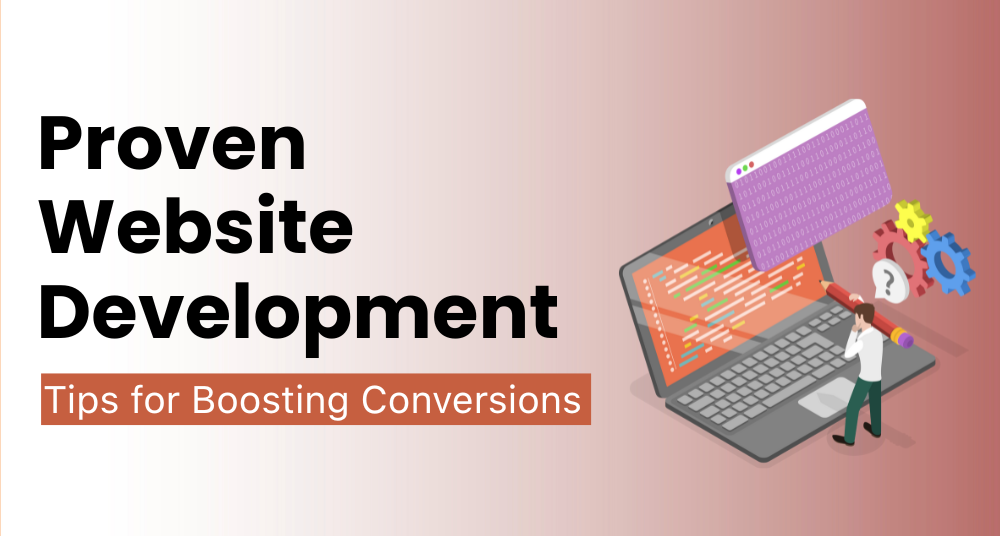In the digital age, your website is more than just an online presence—it’s a powerful sales tool. Whether you’re an eCommerce business, SaaS company, or service provider, your website’s ability to convert visitors into customers directly impacts your bottom line. But what makes a website high-converting?
It’s not just design—it’s strategy, functionality, performance, trust, and psychology, all implemented by skilled developers. In this detailed guide, we explore the best practices developers must follow to build a high-converting website in 2025.
Start with the Right Foundation: Define Conversion Goals
Before writing a single line of code, developers must understand the core goal of the website:
- Is it to sell products?
- Generate leads?
- Get demo bookings?
- Capture emails?
Without a clear goal, development becomes directionless. Developers should work closely with the marketing and business teams to map out:
- Conversion KPIs (CTR, signup rate, sales)
- Desired user journeys
- Call-to-action (CTA) placements
Tools to assist:
- Google Analytics
- Hotjar or Microsoft Clarity (user journey tracking)
Choose a Conversion-Friendly Tech Stack
High-converting websites are lightning-fast, secure, scalable, and SEO-optimized. This depends largely on the tech stack.
Recommended Stack:
Frontend: React.js, Next.js (supports SSR and fast rendering)
Backend: Node.js, Django, Laravel
Database: PostgreSQL, MongoDB
CMS: Headless CMS (Strapi, Sanity, Contentful)
Hosting/CDN: Vercel, Netlify, Cloudflare, AWS
Bonus: Use JAMstack architecture for ultra-fast performance and security.
Design for Speed: Website Performance is Critical
Google data shows that 53% of users abandon websites that take over 3 seconds to load.
Developer Action Points:
- Minify CSS, JavaScript, and HTML
- Use lazy loading for images and videos
- Implement code splitting and bundling (e.g., in Webpack)
- Enable GZIP/Brotli compression
- Implement caching (browser + server-side)
- Use CDN (Cloudflare, Fastly) to serve assets globally
Measure with:
- Google PageSpeed Insights
- Lighthouse
- WebPageTest
- Tool. Pingdom
- GTmetrix
Prioritize Mobile-First and Responsive Design
Over 60-70% of global traffic comes from mobile devices. Responsive design isn’t optional—it’s essential.
Best Practices:
- Use flexible grids (CSS Grid, Flexbox)
- Ensure CTAs and menus are thumb-friendly
- Implement adaptive images (different resolutions for different screens)
- Test across real devices, not just emulators
Structure for Easy Navigation and UX
Confused users don’t convert. Create a clear, intuitive navigation path to keep visitors moving toward the goal.
Developer Tips:
- Limit primary menu to 5-7 items
- Implement sticky headers or mobile hamburger menus
- Use breadcrumbs on subpages
- Keep the homepage uncluttered, with visible CTAs above the fold
Build for Trust and Credibility
Users need to trust your website before they give information or make purchases.
Trust-Building Features:
- HTTPS with valid SSL
- Visible contact details
- Trust badges (e.g., Norton Secured, payment logos)
- Testimonials, ratings, and reviews
- Links to privacy policy, refund policy, T&C
Use High-Converting UI/UX Design Principles
Developers should implement design concepts that influence how users interact.
Design Psychology:
F-pattern and Z-pattern layouts: Align content in scan-friendly ways
CTA button colors: Use contrast (e.g., orange or green for action)
Visual hierarchy: Use headings, font size, and white space effectively
Micro-animations: Highlight CTAs or form fields subtly
Fast, Simple, and Smart Forms
Forms are often the final step before conversion. Don’t let poor form design kill conversions.
Developer Checklist:
- Use smart field auto-fill
- Limit the number of fields (only ask what’s necessary)
- Real-time error handling
- Mobile-friendly input design
- Use conversational forms (multi-step with progress bars)
Integrate Analytics and Conversion Tracking
Developers should integrate tracking systems to measure conversion performance.
Must-Have Tools:
- Google Analytics 4 (GA4)
- Google Tag Manager (set custom events like form submissions, CTA clicks)
- Meta Pixel (for ad conversion tracking)
- Hotjar or Clarity (for heatmaps and behavior analytics)
Implement SEO-Ready Development Practices
Developers should follow technical SEO best practices to improve discoverability.
On-Page SEO Must-Haves:
- Semantic HTML5 (use <header>, <article>, <section>)
- Meta tags, OpenGraph tags
- Robots.txt + XML sitemap
- Clean, descriptive URL structures
- Structured data/schema markup for rich snippets
- Fast loading on mobile (Core Web Vitals optimization)
- Make It Accessible to Everyone (WCAG Compliance)
An accessible website not only expands your user base but also helps avoid legal issues.
Accessibility Tips:
- Provide text alternatives (alt text) for all images
- Use proper heading hierarchy (H1 → H2 → H3)
- Ensure keyboard navigation
- Maintain proper contrast ratios
- Use ARIA roles where needed
Continuous A/B Testing and Iteration
The first version of your website isn’t the final version. Run A/B tests to continually optimize for conversions.
A/B Testing Ideas:
Test CTA text (e.g., “Get Started” vs. “Try for Free”)
Test hero images
Try different form placements
Use different pricing page layouts
Tools:
- Google Optimize
- VWO
- Optimizely
Optimize Checkout and Payment Processes (For eCommerce)
If you’re building a store, your checkout flow should be smooth and reassuring.
Checkout Best Practices:
- Guest checkout options
- Progress indicators
- Autofill shipping fields
- Secure payment gateways (Stripe, Razorpay, PayPal)
- Clear shipping and return policies
Frequently Asked Questions [FA’QS]
What makes a website “high-converting”?
A high-converting website effectively turns visitors into customers or leads through fast performance, clear CTAs, good UX, and persuasive content.
How important is website speed for conversions?
Very important. A delay of even 1 second in load time can drop conversions by up to 7%. Fast websites keep users engaged and more likely to take action.
Why does mobile responsiveness matter?
Over 60-70% of users access websites on mobile. A responsive design ensures the site looks and functions well on all devices, which boosts conversions.
What role do CTAs play in conversions?
CTAs guide users to take specific actions like “Buy Now” or “Get a Quote.” Clear, strategically placed CTAs increase the chances of conversion.
How can I measure website conversions?
Use tools like Google Analytics, Hotjar, and Google Tag Manager to track user behavior, form submissions, and clicks on CTAs.
Related Blog: Top Website Development Trends 2025
Conclusion: Developers Drive Conversions
High-converting websites aren’t built with luck. They’re built with strategy, skill, and smart coding. From performance and responsiveness to UX and SEO, developers are at the heart of successful conversion-focused websites.
By adopting these best practices, you can build digital experiences that don’t just attract users—but convert them.






What do you think?
It is nice to know your opinion. Leave a comment.